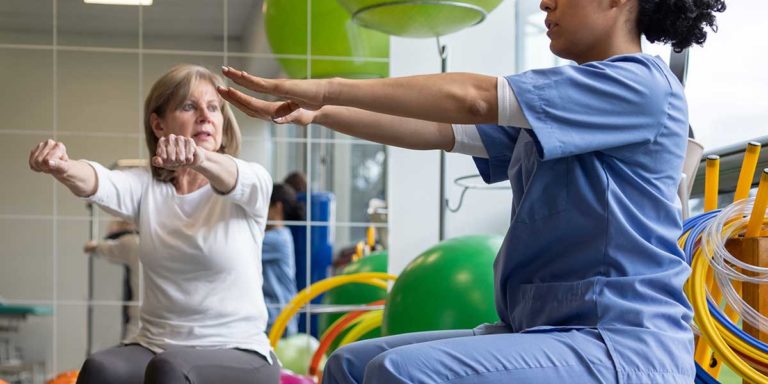What is the difference between Occupational Therapy and Physical Therapy?
Therapeutic Potentials, Inc. offers area-leading physical therapy and occupational therapy for adults and children in Southwestern Florida. These related yet diverse fields of health care are invaluable for individuals with acute and chronic health conditions looking to increase their independence and quality of life.
While similar, these professions are distinct and offer unique benefits to patients and their caregivers. Keep reading to learn more about the differences are between occupational therapy vs physical therapy.
The Role of the Occupational Therapist vs Physical Therapist Defined
To begin our discussion about physical therapy vs occupational therapy, let’s look at how each profession’s governing body defines the roles of their practitioners, called physical therapists (PTs) or occupational therapists (OTs).
According to the American Physical Therapy Association (APTA), physical therapists are “movement experts who improve quality of life through prescribed exercise, hands-on care, and patient education.” Physical therapists are trained to “examine each person and then [develop] a treatment plan to improve their ability to move, reduce or manage pain, restore function, and prevent disability.”
According to the American Occupational Therapy Association (AOTA), occupational therapists are trained to “[promote] physical and mental health and well-being by supporting occupational performance in people with, or at risk of experiencing, a range of developmental, physical, and mental health disorders.” In this case, “occupational” can refer to a person’s actual career or job, but may also refer to a person’s other “occupations” of life such as caring for themselves, caring for their loved ones, or even (in the case of children) playing and going to school.
Both physical therapists and occupational therapists must undergo rigorous training, including undergraduate studies, post-graduate courses, and immersive clinical internships. OTs and PTs, many of whom hold doctorate degrees and advanced specialities, are licensed and board-certified, and in most states must fulfill a minimum number of annual continuing education hours to maintain licensure.
PTs and OTs fall within a broad group of health care providers known as allied health professionals, along with other providers such as speech language pathologists, respiratory therapists, and dietitians. Allied health professionals are distinct from providers of medicine and nursing, and can diagnose, evaluate, and treat disease and promote disease prevention through the use of evidence-based practices and interventions.
Key Differences Between OT vs PT
Now that we have some big-picture definitions of OT vs PT, let’s look at some practical examples of how this translates to real-world treatment.
When working with a patient and their caregivers, a physical therapist will likely focus on things like:
- Improving a person’s gross motor skills, balance, coordination, range of motion, endurance, and strength
- Improving a person’s ability to safely move about their home, community, work, and/or school environments (helping patients “get from Point A to Point B”)
- Issuing adaptive equipment that can assist with locomotion and mobility, such as walkers, crutches, and wheelchairs
- Educating family members and caregivers on how to physically assist loved ones, prevent falls, and promote safety
In contrast, when working with a patient and their caregivers, an occupational therapist will likely focus on things like:
- Improving a person’s fine motor skills such as manipulating buttons, utensils, pens, and keyboards
- Improving a patient’s ability to perform activities of daily living (ADLs), such as bathing, dressing, and grooming
- Issuing adaptive devices that can assist with ADL performance, including hand splints and utensils with built-up handles
- Educating patients and loved ones about cognitive and mental strategies to help patients improve ADL performance, academic performance, and general coping skills
Physical therapists and occupational therapists both:
- Work in a variety of settings, including outpatient clinics, schools, hospitals, nursing facilities, and home health
- Work with individuals at all stages of life who are experiencing various health challenges, including congenital and neurodevelopmental conditions like Down syndrome, cardiovascular conditions like stroke, orthopedic conditions like arthritis and total joint replacement surgery, and neurological conditions like Alzheimer’s disease and traumatic brain injury
- Prescribe exercises, stretches, and manual therapy to enhance recovery, ease symptoms like pain, and improve overall wellness
- Collaborate with each other as well as other interdisciplinary professionals, including orthopedic surgeons and neurosurgeons, speech therapists, and school educators
- Are problem solvers, utilizing their training in evidence-based care to adapt, modify, and progress activities in order to help patients and their caregivers be successful!
A common myth is that occupational therapists only treat the arms and that physical therapists only treat the legs. While it’s true that OTs and PTs may spend more time addressing impairments of the upper vs lower extremities, respectively, both professions utilize a “whole person” approach to their care and can address issues affecting multiple areas or systems within the body.
The bottom line: occupational therapists and physical therapists do have some overlap in their scope of practice, yet are experts within their specific areas of rehabilitation. Both offer services that are effective as stand-alone interventions, but can complement and enhance each other when provided concurrently.
Were You or Your Loved One Referred to Physical Therapy or Occupational Therapy?
If you’re looking for occupational therapy or physical therapy in Lakewood Ranch, Bradenton, or Sarasota FL, connect with our experienced team at Therapeutic Potentials, Inc. We’d be happy to support you on your journey as you recover from an acute illness or injury, surgery, or other health concern. Call TPI now at 941-758-3140 to schedule your initial appointment.







